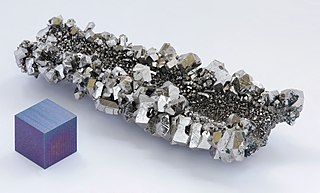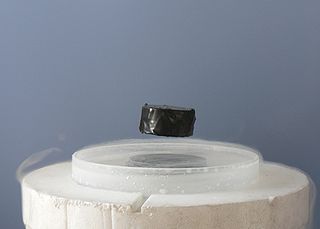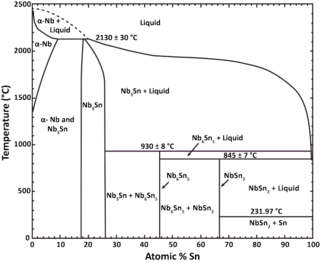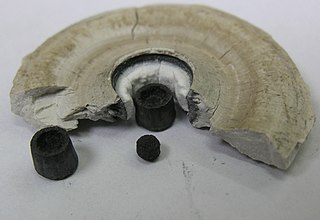Related Research Articles

Niobium, also known as columbium, is a chemical element with the symbol Nb and atomic number 41. Niobium is a light grey, crystalline, and ductile transition metal. Pure niobium has a Mohs hardness rating similar to that of pure titanium, and it has similar ductility to iron. Niobium oxidizes in the earth's atmosphere very slowly, hence its application in jewelry as a hypoallergenic alternative to nickel. Niobium is often found in the minerals pyrochlore and columbite, hence the former name "columbium". Its name comes from Greek mythology, specifically Niobe, who was the daughter of Tantalus, the namesake of tantalum. The name reflects the great similarity between the two elements in their physical and chemical properties, making them difficult to distinguish.

Superconductivity is a set of physical properties observed in certain materials where electrical resistance vanishes and magnetic flux fields are expelled from the material. Any material exhibiting these properties is a superconductor. Unlike an ordinary metallic conductor, whose resistance decreases gradually as its temperature is lowered even down to near absolute zero, a superconductor has a characteristic critical temperature below which the resistance drops abruptly to zero. An electric current through a loop of superconducting wire can persist indefinitely with no power source.

High-temperature superconductors are operatively defined as materials that behave as superconductors at temperatures above 77 K, the boiling point of liquid nitrogen, one of the simplest coolants in cryogenics. All superconducting materials known at ordinary pressures currently work far below ambient temperatures and therefore require cooling. The majority of high-temperature superconductors are ceramic materials. On the other hand, Metallic superconductors usually work below -200 °C: they are then called low-temperature superconductors. Metallic superconductors are also ordinary superconductors, since they were discovered and used before the high-temperature ones.

A superconducting magnet is an electromagnet made from coils of superconducting wire. They must be cooled to cryogenic temperatures during operation. In its superconducting state the wire has no electrical resistance and therefore can conduct much larger electric currents than ordinary wire, creating intense magnetic fields. Superconducting magnets can produce greater magnetic fields than all but the strongest non-superconducting electromagnets and can be cheaper to operate because no energy is dissipated as heat in the windings. They are used in MRI machines in hospitals, and in scientific equipment such as NMR spectrometers, mass spectrometers, fusion reactors and particle accelerators. They are also used for levitation, guidance and propulsion in a magnetic levitation (maglev) railway system being constructed in Japan.

Yttrium barium copper oxide (YBCO) is a family of crystalline chemical compounds, famous for displaying high-temperature superconductivity. It includes the first material ever discovered to become superconducting above the boiling point of liquid nitrogen (77 K) at about 92 K. Many YBCO compounds have the general formula YBa2Cu3O7−x (also known as Y123), although materials with other Y:Ba:Cu ratios exist, such as YBa2Cu4Oy (Y124) or Y2Ba4Cu7Oy (Y247). At present, there is no singularly recognised theory for high-temperature superconductivity.

Superconductivity is the phenomenon of certain materials exhibiting zero electrical resistance and the expulsion of magnetic fields below a characteristic temperature. The history of superconductivity began with Dutch physicist Heike Kamerlingh Onnes's discovery of superconductivity in mercury in 1911. Since then, many other superconducting materials have been discovered and the theory of superconductivity has been developed. These subjects remain active areas of study in the field of condensed matter physics.
Grenoble High Magnetic Field Laboratory, published in August 2005's issue of Science, that uranium rhodium germanium (URhGe) is the first discovered metal that becomes superconducting in the presence of an extremely strong electromagnetic field. Very unlike other superconducting materials, whose superconducting properties can be lost due to strong magnetic fields, uranium rhodium germanium actually regains superconducting abilities at about 8 teslas.

Niobium–tin is an intermetallic compound of niobium (Nb) and tin (Sn), used industrially as a type II superconductor. This intermetallic compound has a simple structure: A3B. It is more expensive than niobium-titanium (NbTi), but remains superconducting up to a magnetic flux density of 30 teslas [T] (300,000 G), compared to a limit of roughly 15 T for NbTi.
Niobium–titanium (Nb-Ti) is an alloy of niobium and titanium, used industrially as a type II superconductor wire for superconducting magnets, normally as Nb-Ti fibres in an aluminium or copper matrix.

The A15 phases (also known as β-W or Cr3Si structure types) are series of intermetallic compounds with the chemical formula A3B (where A is a transition metal and B can be any element) and a specific structure. Many of these compounds have superconductivity at around 20 K (−253 °C; −424 °F), which is comparatively high, and remain superconductive in magnetic fields of tens of teslas (hundreds of kilogauss). This kind of superconductivity (Type-II superconductivity) is an important area of study as it has several practical applications.

Niobium nitride is a compound of niobium and nitrogen (nitride) with the chemical formula NbN. At low temperatures NbN becomes a superconductor, and is used in detectors for infrared light.
Superconductors can be classified in accordance with several criteria that depend on physical properties, current understanding, and the expense of cooling them or their material.

Covalent superconductors are superconducting materials where the atoms are linked by covalent bonds. The first such material was boron-doped synthetic diamond grown by the high-pressure high-temperature (HPHT) method. The discovery had no practical importance, but surprised most scientists as superconductivity had not been observed in covalent semiconductors, including diamond and silicon.

Superconducting wires are electrical wires made of superconductive material. When cooled below their transition temperatures, they have zero electrical resistance. Most commonly, conventional superconductors such as niobium-titanium are used, but high-temperature superconductors such as YBCO are entering the market.
The superconducting tunnel junction (STJ) — also known as a superconductor–insulator–superconductor tunnel junction (SIS) — is an electronic device consisting of two superconductors separated by a very thin layer of insulating material. Current passes through the junction via the process of quantum tunneling. The STJ is a type of Josephson junction, though not all the properties of the STJ are described by the Josephson effect.
Vanadium–gallium (V3Ga) is a superconducting alloy of vanadium and gallium. It is often used for the high field insert coils of superconducting electromagnets.

The superconducting nanowire single-photon detector (SNSPD) is a type of near-infrared and optical single-photon detector based on a current-biased superconducting nanowire. It was first developed by scientists at Moscow State Pedagogical University and at the University of Rochester in 2001. The first fully operational prototype was demonstrated in 2005 by the University of Rochester, the National Institute of Standards and Technology (Boulder), and BBN Technologies as part of the DARPA Quantum Network.

Niobium diselenide or niobium(IV) selenide is a layered transition metal dichalcogenide with formula NbSe2. Niobium diselenide is a lubricant, and a superconductor at temperatures below 7.2 K that exhibit a charge density wave (CDW). NbSe2 crystallizes in several related forms, and can be mechanically exfoliated into monatomic layers, similar to other transition metal dichalcogenide monolayers. Monolayer NbSe2 exhibits very different properties from the bulk material, such as of Ising superconductivity, quantum metallic state, and strong enhancement of the CDW.
John Kenneth Hulm was a British-American physicist and engineer, known for the development of superconducting materials with applications to high-field superconducting magnets. In 1953 with George F. Hardy he discovered the first A-15 superconducting alloy.
References
- ↑ Oya, Gin-ichiro; E. J. Saur (1979). "Preparation of Nb3Ge films by chemical transport reaction and their critical properties". Journal of Low Temperature Physics. 34 (5–6): 569–583. Bibcode:1979JLTP...34..569O. doi:10.1007/BF00114941. S2CID 119846986.[ dead link ]
- ↑ "Physics Today". American Institute of Physics. October 1973. Archived from the original on 2013-04-15.
- ↑ "Superconducting devices". TheFreeDictionary. Retrieved 2008-09-06.
- ↑ Sinha, P. K. (1987). Electromagnetic Suspension: Dynamics & Control. The Institution of Engineering and Technology. p. 290. ISBN 978-0-86341-063-5.